Mount Rainier Climbing Synopsis
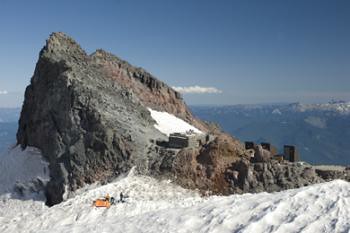
Camp Muir 10,000'
©Bert Gildart: What follows is a short synopsis of my climb up 14,411 foot-high Mount Rainier this past week. As well, I’m including a few thoughts of what I believe you might expect of a guide.
Our trip of two guides and four clients began at Paradise, elevation about 5,000’, at approximately 10 a.m. Most of us were a bit older, which our guides completely understood. At 67, I was the oldest.
Our first destination was Camp Muir, a distance of about four miles and as we climbed we moved along steadily. About half way up we passed Pebble Creek, last place from which guides said were we could obtain fresh running water. Shortly thereafter we hit the Muir Snow field and then, several hours later, we reached Camp Muir, the historic old camp that had been named for John Muir. Muir, of course, was a wilderness proponent and the founder of the Sierra Club.
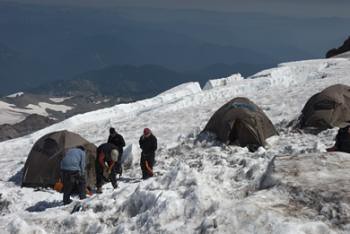
Camp Ingrahm
At that point our elevation was about 10,000 feet, and we all seemed to handle the thin air well. The camp consists of a stone hut where independent climbers were overnighting. International Mountain Guides had established a nearby tent camp and though the outside air was comfortable, we all enjoyed a break from the elements and a warm meal.
Because Paul Baugher, one of the owners of IMG, had arranged a private outing, we had to camp away from the Camp Muir, which we did, hiking first about a mile across Cowlitz Glacier toward Cathedral Rocks. There we used shovels and our ice axes to carve back the ice and create a platform for our tents. Later, we enjoyed another warm meal cooked by Aaron Mainer. Our camp was gorgeous and it was backdropped by Adams, Mount Hood and by Mount St. Helens.
The next day we continued a short distance, ascending Cathedral Rocks which then leveled out onto Ingraham Glacier. Once again IMG had established a seasonal intermediate camp, though this one about two- thousand feet higher, meaning we had ascended to an elevation of about 12,000 feet. Because some of the ice had shifted, we had to reposition one of the tents, requiring the construction of another ice platform.
Essentially, the remainder of the day was one of relaxation, and that evening after another hearty meal, we retired at 5 p.m. Though it is doubtful any of us slept, all seemed to rest, and that was fortunate, for we were about to embark on the most difficult part of our ascent.
At 11 p.m., Paul awakened us all and we enjoyed yet another meal. Then, to avoid the warming influence of sun on snow and the avalanches and rock falls warmed snow might trigger, we struck out at 1 a.m., and did so at what was a very brisk pace. Before we had gone an hour, one in the party had to drop out because of the flare up of a reoccurring injury. Aaron took him back to our Ingrahm Glacier Camp.
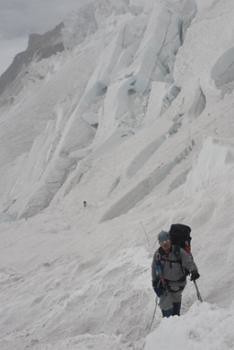
Emmons Glacier Route to Summit
As we continued, we remaining four passed around Disappointment Cleaver and crossed over an ice bridge that peered down into a deep crevasse. Rangers had installed a balance rope and in addition, Paul inserted an anchor and belayed us over the bridge so providing yet extra security. Shortly thereafter we passed at least one group that surely was half my age. The wind had picked up and Paul felt we should press on. At this point we had crossed onto Emmons Glacier, largest outside of Alaska. This would be our conduit to the top.
From this point, the ascent became particularly steep, and I do not think it an exaggeration to say that the steepness of the ascent approached 45 degrees. Training that IMG had provided really paid off, for it was the “rest step” grilled into us over and over and now repeated thousands of times that eventually helped us ascend the last 1,500 feet. Still, it was a struggle.
As we neared the top the wind began gusting and because it knocked both Knox and me flat onto our rears, we concluded it was blowing close to 70 miles per hour. The air here was thin, and perhaps that, too, had robbed us of the strength we needed to stay erect, for on several more occasions it again knocked me flat.
At 7 a.m. we finally reached the top, but it was a virtual whiteout. A wan sun tried to break through the swirling clouds but without success. Still, we knew we were in a huge cinder cone, created by a huge volcanic that is still active. Nevertheless, I pulled out my camera, took photos of the group, and then we began our return.
Several days after returning, I poked around on other web sites and discovered that most climbers had more difficulty with the return trip than with any other portion, for climbers must now descend almost 10,000 feet—and generally all in the remainder of that day. But some, I discovered, returned to Camp Muir, slept, and then descended, adding yet another day to their outing. Others (and these were apparently much younger groups) simply took an hour or two longer, returning to Paradise at 8 or 9 in the evening rather than 6, as did we. One group I read about didn’t return until after midnight.
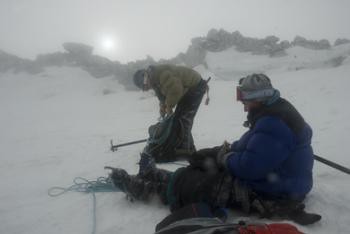
The Summit 14,000' plus
I would have preferred a slower pace. As it was we reached Paradise about 5:30, descending through clouds backdropped once again by Mount Adams. An hour later I was back at our Airstream Trailer, and, my, but did it look good! Janie was waiting (and, yes, she looked good too!!) and Knox gave her a thumbs up. She smiled and I actually thought she was glad to see me back safe and sound. Then, she wanted to know everything about our climb, and that’s something I’m still evaluating.
Bottom line, I made it and doubt I would have succeeded on a first attempt without such excellent guidance. Nevertheless, I’m providing a few thoughts about the understanding you and your guide should have.
In summary, if you’re joining a guided trip, ask your guide in advance what kind of latitude you might have.
If you want take photos, will you have time?
If you are slow, but believe you ultimately have the stamina to reach the top, will you be forced into a pace that is totally exhausting? If you’re older but in good shape, recuperative powers still kick in, though sometimes it takes a few more minutes. If you’re not in shape, it doesn’t make any difference how young you are, and you will probably fall into that 50% of climbers who don’t summit.
By and large our guides were cognizant of our concerns and these suggestions are simply intended to help you shape questions that you might want to ask your guide prior to signing on.
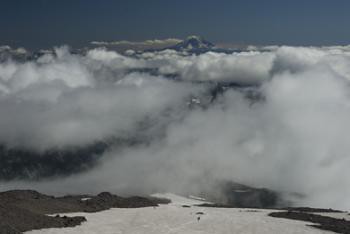
Clouds Below 10,000' and Mount Adams
Would I do it again? You bet, and am, in fact, contemplating a three score and 10 climb. Because that’s the time supposedly allotted to us here on this Good Earth that will be my Biblical climb.


August 26th, 2007 at 6:56 am
Bert,
Love hearing about this! Thanks for sharing!!!
Rich
September 10th, 2007 at 1:55 pm
Beautifully done space. Love it! I’m new to all this so appreciate any input as to my space.
Artist, maker of wildflower gardens and koi ponds, photographer, specialist in digital manipulations of natural subjects, multilayered over drawings… philosophical… pensive, active, Colorado horseback-riding, skier.
I love the look and tone you’ve developed here. I have a daughter who is a younger version of you. She spent all summer in the back country doing 14-er trail work and is on her way to Thailand next month. Hope she gets a chance to see what you and your wife are doing. ALso an artist photographer, budding. You are inspirational.